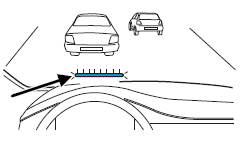Operation

The radar sensor detects vehicles ahead that are moving in the same direction as your vehicle.
If the radar detects that your vehicle is rapidly closing in on another vehicle, a red warning light will illuminate and an audible warning chime will sound.

After that, if the risk of collision further increases after the warning light, the brake support prepares the brake system for rapid braking.
This may be apparent to the driver.
However, the system will not automatically activate the brakes.
The vehicle will not stop unless the driver presses the brake pedal. If the brake pedal is pressed then braking is implemented with full brake function, even if the force on the brake pedal is light.
The collision warning system is active at speeds above approximately 5 mph (8 km/h).

See also:
Interior mirror
The interior rearview mirror has two pivot points on the support arm
which lets you adjust the mirror up or down and from side to side.
WARNING: Do not adjust the mirror while the vehicle is in
m ...
Replacing headlamp bulbs
High beam/low beam bulb replacement
For driver side replacement of the high beam/low beam bulbs, do the
following:
1. Make sure the headlamp switch is in the off position, then open the
hood.
2 ...
Installing child safety seats with LATCH (Lower Anchors and Tethers for
CHildren) attachments
The LATCH system is composed of three vehicle anchor points: two (2)
lower anchors located where the vehicle seat back and seat cushion meet
(called the “seat bight”) and one (1) top tether anchor ...
